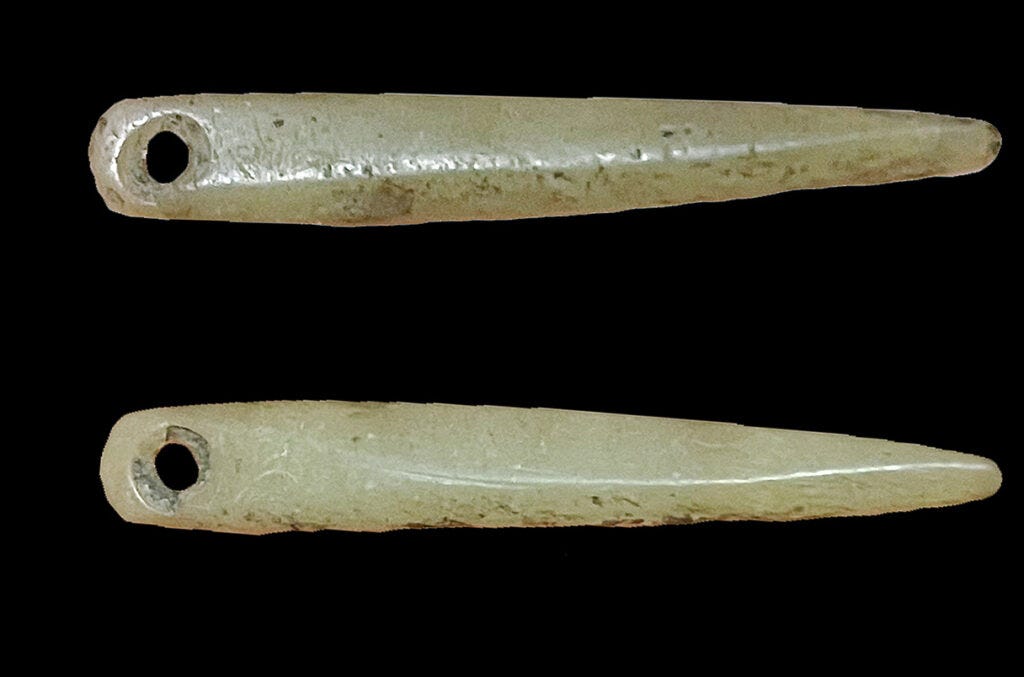🧐 Ancient Beat #116: Late Denisovans, stone needles, and the not-so-sudden demise of Cahokia
Hi folks! Welcome to issue #116 of Ancient Beat. Sad to say that Virginia’s 3-week internship ends today — huge thanks to her for all the help! She will be missed. 🙏
Here’s the latest ancient news. 👇
🗞 Ancient News: Top 5
Bone Remains Indicate Extinct Humans Survived on the Tibetan Plateau for 160,000 Years — Bone remains found in a Tibetan cave 10,760 feet above sea level indicate Denisovans survived there for millennia. Denisovans, an extinct species of ancient humans, lived alongside Neanderthals and Homo sapiens. A study of over 2,500 bones from Baishiya Karst Cave on the Tibetan Plateau identified a new Denisovan fossil, showing their survival from around 200,000 to 40,000 years ago despite fluctuating climatic conditions — the new Denisovan rib bone dated between 48,000 and 32,000 years ago indicated their presence during modern human dispersal across Eurasia. Analysis revealed Denisovans hunted and butchered various animals, including blue sheep, wild yaks, equids, wooly rhinos, spotted hyenas, small mammals, and birds. Despite harsh conditions, the Ganjia Basin provided a stable environment for Denisovans.
New Study Challenges Drought Theory for Cahokia Exodus — The Cahokia Mounds, located in present-day Illinois, were once home to a thriving metropolis of around 50,000 people. By 1400 CE, the area was largely abandoned. A popular theory suggests a prolonged drought led to a massive crop failure, causing the exodus. However, a new study challenged this view. Soil isotope analysis from the site shows consistent ratios of Carbon 12 and Carbon 13 during the period in question, indicating no significant shift in plant types that would signal widespread crop failure. The study suggests Cahokians might have had advanced irrigation techniques and a varied diet, including stored grains and diverse food sources like fish, birds, and forest fruits, making them resilient to drought. Instead of a sudden mass departure, the exodus from Cahokia was likely gradual, influenced by social factors and opportunities elsewhere
Wall Built to Contain Spartacus Discovered — In the Dossone della Melia forest in Italy, a stone wall and earthwork extending over 1.7 miles, have been discovered. The wall, part of a Roman defensive system, was built by Marcus Licinius Crassus to trap Spartacus and his forces. Evidence of a battle includes broken iron weapons like sword handles, large curved blades, javelin points, and spearheads. The discovery was facilitated by environmentalists and confirmed using Ground-Penetrating Radar, LIDAR, and soil core sampling.
The World’s Earliest Ground Stone Needles: Archaeological Evidence from the Early Holocene of the Western Tibetan Plateau — Six ground stone perforated needles were found in the Xiada Co site in Tibet. They date back to 8,900-8,500 years ago, making them the earliest known stone needles in Eurasia. These artifacts, made from rare minerals like tremolite and serpentine, suggest advanced technological skills and were likely used for sewing tents and possibly for symbolic purposes, as evidenced by pigment residues. This discovery highlights unique adaptive behaviors of early humans on the Tibetan Plateau.
Anglo-Saxons May Have Fought in Northern Syrian Wars, Say Experts — According to new research, 6th-century Anglo-Saxon warriors may have traveled from Britain to the eastern Mediterranean and northern Syria to join Byzantine military campaigns. Exotic items found at Sutton Hoo, Taplow, and Prittlewell originated from these regions, and objects like Sasanian seals and silver drachms challenge the notion that non-local items arrived solely through trade. Finds also include Eurasian-style armor and riding apparel common in the Byzantine and the Sasanian empires. Examples of the items that were analyzed include Byzantine silverware at Sutton Hoo, a Eurasian-style riding jacket at Taplow, and a copper flagon with a Sasanian-style roundel at Prittlewell, Syrian bitumen lumps at Sutton Hoo, and a pottery bottle typical of northern Mesopotamia.
That’s it for the free Top 5! If you’re a free subscriber, sign up for the paid plan for another 14 discoveries and 3 recommended pieces of content covering a new Antikythera shipwreck, cave rituals, the evolution of clothing, and the German Stonehenge.
Until next time, thanks for joining me!
-James
Twitter: @jamesofthedrum
P.S. If you want access but it’s a little too steep for you right now, just email me — I want this to be accessible.
P.P.S. Paid members, read on!
🗞 Ancient News: Deep Dive
Keep reading with a 7-day free trial
Subscribe to Ancient Beat to keep reading this post and get 7 days of free access to the full post archives.



